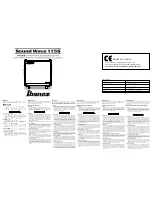
65 Aleksandar Stamboliyski Str., 8000 Bourgas, Bulgaria
Tel: +359 56 820027, Fax: +359 56 836700
E-mail: [email protected] ,Web: www.devabroadcast.com
- 21 -
Co-channel Interference
In many populated areas, there just isn’t much room in the radio spectrum and stations will be
jam-packed in. Another thing which would result in mutual interference between the broadcasting
stations is poor frequency planning.
The inherent broad bandwidth of the DB4005 receiver is vulnerable from stations working on
the nearby frequencies, where signal strength will be the most important factor – the stronger the
interfering station, the stronger the interference effect.
One method to identify adjacent channel interference is to observe independent positive and
negative deviation readings. If the positive deviation is considerably higher then the negative
one, interference from a strong station above the monitored frequency would be indicated and
vice–versa. In this example the negative deviation can probably be trusted as an indication of total
carrier modulation, though this should be confirmed in free of interference RF environment.
In any event program deviation should be fairly symmetrical about the carrier frequency. Using
the built-in Attenuator can be of some help, but using of an outdoors directional antenna could
dramatically improve the situation with unwanted adjacent working stations. Other solutions
include a band-pass filter at the primary frequency or a trap at the interfering frequency.
















































